Online learning platforms are great for helping you set up or teach a course. Often, you can also leverage them to monetize your own content, too! Creators everywhere are learning how to build an online learning platform so that they can generate new revenue streams.
But, there are a lot of online learning platforms out there, so how do you choose? Start by exploring these top picks!
Skip ahead:
- The value of online learning platforms
- How to choose the best online learning platform
- The difference between online learning platforms and learning management systems
- 10 best online learning platforms
- Tips to monetize your courses
What value do online learning platforms bring?
In a paper titled Online Learning Platforms: Reconstructing Modern Higher Education, Zi-Yu Liu, Natalya Lomovtseva and Elena Korobeynikova argue that online learning platforms can change the way higher education works in the future. They said the greatest benefits to this type of tool includes, “greater freedom of access, lower education prices, the possibility of dividing the content of the e-course into modules, flexibility of education, the ability to keep up with modern pace of life, and the ability to define criteria for assessing knowledge.”
How to choose the best online learning platform
In general, you should look at structure, course content, community and price when evaluating which online learning platform is best suited for you. This will apply regardless if you’re using it to learn or to monetize your content!
Choosing the right online learning platform will generally mean balancing these four aspects in a way that works best for you.
Structure of the platform
Course structure is important because it leads to a better learning experience and more effective delivery of professional development programs. As an example, you can probably piece together knowledge on almost any topic through YouTube, but it would lack a structured and progressive environment. This would make it hard for students to learn independently.
Available course content
Looking at the course content is key to whatever you’re planning to learn or teach. All online degree programs and course materials are somewhat unique in how they approach any given subject. Take web development or programming, for example. There are so many principles, languages and frameworks that you can learn that it can’t simply be covered by individual courses. Some specialization is necessary.
If you’re planning to deliver a course through an online learning platform, it will help to look for ones that offer similar topics already. You can also look for platforms that offer similar set-ups. Free or mini courses attract a much different audience than Bachelor’s degree programs!
Community support
Community makes the learning process much more fun and effective. When you’re stuck and can ask your peers for help, it reinforces what you’ve just learned with another perspective. Plus, doing something with a cohort of students is much more motivating than going alone.
From the teaching perspective, you can leverage learning communities to empower brainstorming, independent problem-solving, and passion-building for the course topic.
Pricing
Price is another key factor in selecting course materials that work for you. There are many free courses available but paid ones tend to be more engaging and of higher quality. Some courses offer free trials while others offer refunds if you don’t like it. Some courses give you lifetime unlimited access while others rely on a subscription model or only work for a limited time.
Whether you’re monetizing or purchasing a course, you need to consider the value that the course provides to the student. Is the topic of interest, and does it provide enough content to be worth the pricing model offered?
When you’re selling through an online learning tool, you’ll also want to consider if there are any added costs. Sometimes the cost is accrued per sale, and sometimes it is a monthly fee.
What’s the difference between online learning platforms and learning management systems?
When you’re researching which online learning platform is right for you, it’s important to know how it differs from other similar solutions such as learning management systems (LMS) and online course websites.
An online learning platform is a user-facing environment where students can learn new skills. In comparison, a learning management system is a back-end solution that provides all the necessary tools to the online learning platform so it can function smoothly. This would provide features like uploading videos, creating quizzes, grading assignments and much more.
Online learning platforms are similar to online course websites. In practice, the difference is that the online learning platforms tend to offer more flexibility than course websites. Online course websites are used for course creation, whereas online learning platforms can encompass all kinds of learning experiences, from short videos to online degrees.
10 Best online learning platforms
Now that you know what online learning platforms offer, and have a general idea of what you’re planning to study or teach, you can see which one of these 10 top-notch learning platforms suits you best.
Skip ahead here:
Pros
Cons
| |
Pros
Cons
| |
Pros
Cons
| |
Pros
Cons
| |
Pros
Cons
| |
Pros
Cons
| |
Pros
Cons
| |
Pros
Cons
| |
Pros
Cons
| |
Pros
Cons
|
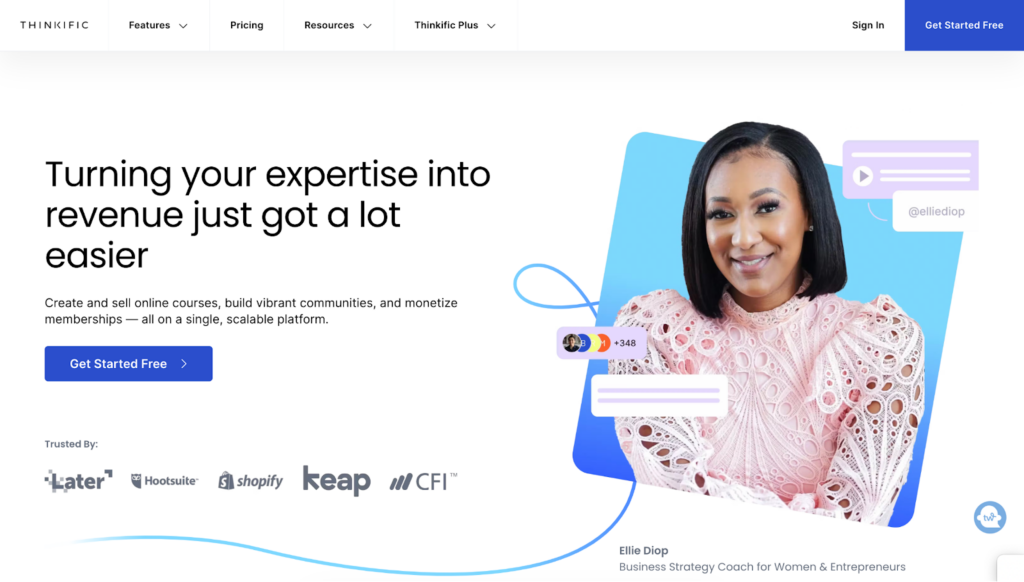
Start by looking into the most flexible online learning platform of all — Thinkific.
Thinkific is not a gallery of courses, rather it’s one of the best platforms to create learning products and organize a custom learning experience for your team. The flexibility of the platform makes it work great for educating students, training employees, and building product education programs, or anything else you can dream up!
Not sure where to start? Thinkific Academy will teach you how to build with an online learning platform, as well as how to price and market your courses effectively.
G2 Score: 4.7/5
Thinkific Pricing
Thinkific has a free plan that allows you to start building courses right away. Paid plans provide you with access to more engagement, tracking, and monetization features, and start at $149 per month.
For learners, Thinkific’s courses are all priced independently by the course creators using the platform. Take some time to research a topic that you love and you’ll likely find a bunch of free courses, too!
Pros
| Cons No library of courses to discover |
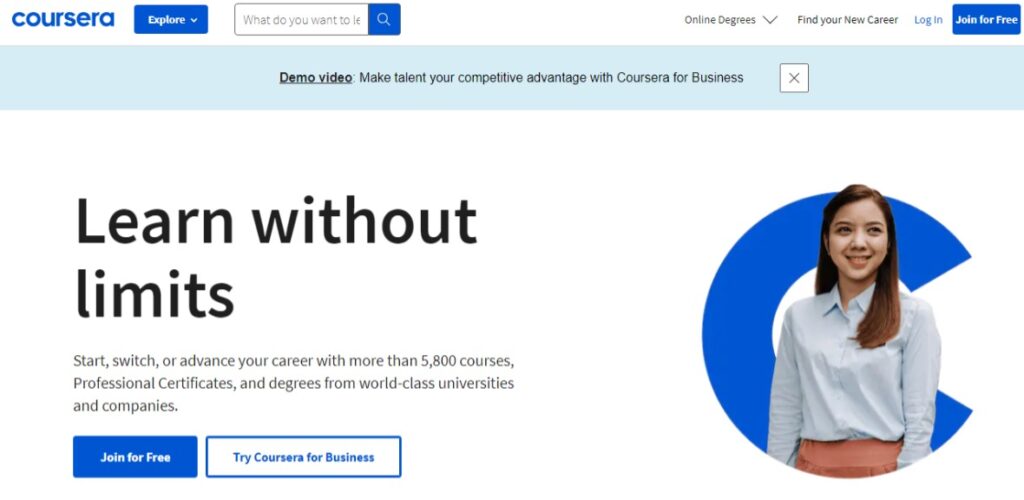
Being one of the largest online learning platforms in the world, Coursera has millions of students and partners with over 200 top universities and companies to produce the best courses across a wide variety of subjects. The platform also offers specific course playlists to help you develop the necessary skills for the job of your dreams!
There are individual courses, certificate courses, and university-level courses available. Some are free and others are paid. You can buy each course separately or enroll in a Coursera Plus plan, which gives you access to all courses for a yearly subscription fee. Note that enrolling in a free Coursera program won’t provide you with a certificate at the completion point.
G2 Score: 4.5/5
Coursera Pricing
Lots of courses are available for free. Paid courses start at $9.99, with certificate-level courses beginning at $39, and university courses at $2,000. You can also choose to pay $59 a month or a $399 annual fee to unlock all the courses on Coursera. However, the monthly or yearly subscriptions do not include university degrees or MasterTrack certificates.
| Pros More than 1,500 courses are free A variety of subjects, from arts to computer science Official certificates recognized by many employers | Cons Free courses don’t come with certificates Some courses have time limits |
Related:
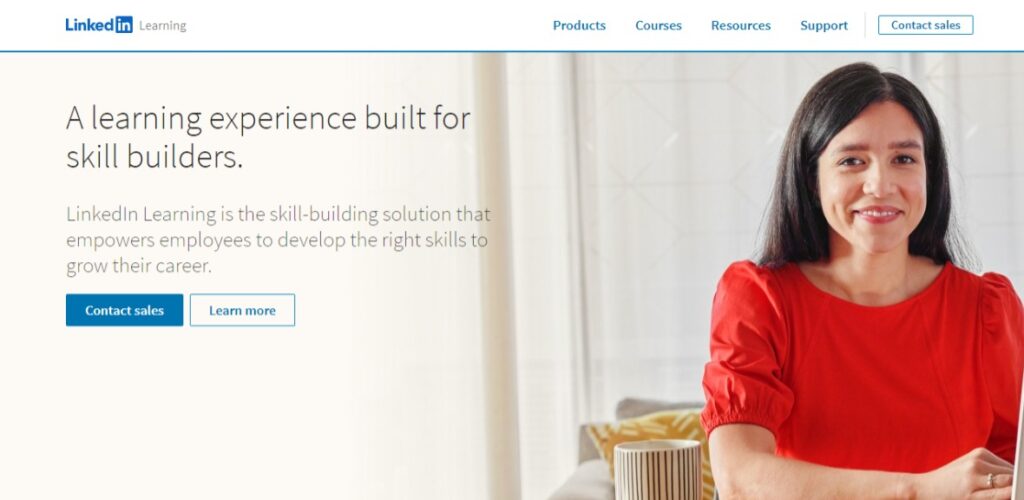
Started as Lynda.com back in 1995, LinkedIn Learning features over 17,000 courses on topics across business, technology and creativity. Experts in their respective fields use LinkedIn Learning as a platform to share their knowledge to others who want to step into the industry.
LinkedIn Learning is great at teaching you how to do complex things, simply. It does this by breaking big, technical topics down into bitesize components. For example, you can learn the ins and outs of Adobe apps like Photoshop, InDesign and Illustrator as well as rendering in Blender, SketchUp and Maya, and much more.
You can buy courses individually or get a recurring subscription. Any certificates can be automatically displayed on your LinkedIn profile.
G2 Score: 4.4/5
LinkedIn Learning Pricing
Individual courses vary between $20 and $50. LinkedIn Learning costs $39.99 for a monthly subscription, and $239.88 for an annual plan (which is a 50% savings!) These plans also give you access to LinkedIn Premium, with advanced networking and career-building tools.
Bulk pricing is also available for companies or educational institutions who want to offer the platform to their organization.
| Pros 17,000+ courses available Detailed how-tos for the most popular software Easily add new certifications to your LinkedIn profile | Cons Need a LinkedIn profile to access learning |
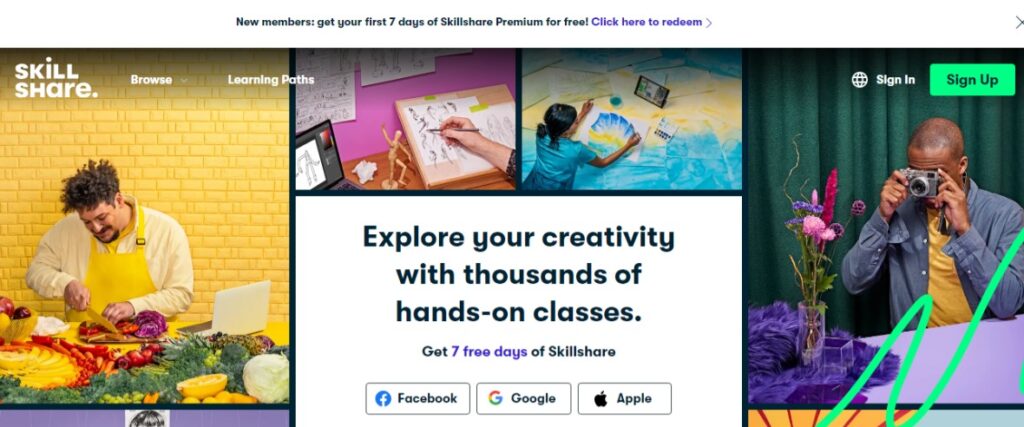
Anyone who’s into creative arts or acquiring new creative skills would appreciate Skillshare. While it is less formal than many other online learning platforms, Skillshare focuses on practical skills rather than degrees or certificates.
Courses on Skillshare are often led by creatives who are well known in their field. The courses rarely go beyond two hours in length and are broken down further into 3 to 5 minute episodes so they’re easier to digest. This makes learning on Skillshare accessible even for people who don’t have a lot of free time at once.
There are some free introductory courses but to get access to the full catalog, you need to purchase a subscription.
G2 Score: 3.4/5
SkillShare Pricing
The pricing seems to depend on the country where you reside. However, on average, you can expect to pay $168 per year, or $14 per month.
| Pros More than 35,000 courses A mobile app for on-the-go learning Learning from “real” people rather than organizations | Cons Courses rarely go in-depth Instructors may not have professional training |
Related: Skillshare vs Thinkific – A detailed comparison

If you’re looking for a more formal learning environment, edX is one of the best options available online. This platform partners with top universities, from Harvard to MIT to Berkeley, to offer real university courses online. This is especially great for learners in remote locations or anyone who doesn’t want to commute to an in-person class for their degree.
Most courses tend to skew into the STEM fields, such as data analysis, engineering, or math. But there are plenty of others too (out of 4,000+ total courses on the platform). You can take the majority of classes for free if you don’t need the certificate.
G2 Score: 4.5/5
edX Pricing
Free classes do not offer certificates. Courses that come with certificates cost between $50 and $300. Full degree programs combine multiple courses and are usually $1,000 or higher.
| Pros A large library of high-quality courses Earn a bachelor’s or a master’s degree Many courses in the sciences Works with globally ranked universities More affordable to get a degree than in-person options | Cons Not as many courses in creative fields |

OpenLearning, an Australian platform, partners with leading institutions and offers more than 4,000 courses on a variety of subjects. What sets OpenLearning apart is an engaging and supportive community of more than 3 million learners. Students interact with each other constantly through comments, submissions and publicly tracking their progress.
You can find short individual courses on the platform as well as OpenCreds, which you can use to get actual credits in Australia’s universities. They call these microcredentials and they fit into specific frameworks for bigger programs you might want to take in the future.
As a bonus, OpenLearning leverages AI technology to continually provide new information and better flow of the online learning experience!
G2 Score: 4.6/5
OpenLearning Pricing
Lots of courses on the OpenLearning platform are free. Although the ones to get university credentials usually cost anywhere between $150 and $500. It costs between $900 and $3,450 per year to create courses on OpenLearning.
| Pros | Cons |
|
|

With more than 213,000 courses, 60,000 instructors, and 62 million students, Udemy is the largest online learning platform out there, covering every niche you can think of.
There’s no unifying theme on Udemy — you can really learn anything, from graphic design to personal development. Most classes also use multimedia technologies, mixing video, images, text, quizzes, etc.
G2 Score: 4.5/5
Udemy Pricing
Each course on Udemy is sold separately, from as little as $10 and up to $200. Udemy subscriptions are not available to all students. Hence, you may have to shell out on individual courses if you are looking for premium learning. Note that only a selection of 10,500 courses from the full catalog are provided to subscribers on the Personal Plan.
| Pros The largest selection of courses 30-day money-back guarantee No subscription No deadlines | Cons Some courses can be low quality (minimal vetting process done by Udemy for instructors) No credits for higher education |
Related:

Web development or programming are hot topics to learn about! And the best online learning platform to do that is Treehouse.
Treehouse specializes in teaching people how to code in an interactive environment. While all courses can be taken individually, most are grouped into tracks to give you well-rounded knowledge of topics like frontend development, cybersecurity, or mobile app development.
Besides videos, Treehouse courses also contain a working text editor you’ll use to complete quizzes and test projects.
G2 Score: 4.3/5
Treehouse Pricing
Treehouse charges $25 per month for regular memberships, or $250 for the annual plan (which essentially gives you two free months). If you want a certificate, however, there are even more structured Techdegree programs starting at $49 per month.
| Pros High-quality progressive courses A handy text editor built right in | Cons Not many options besides programming |
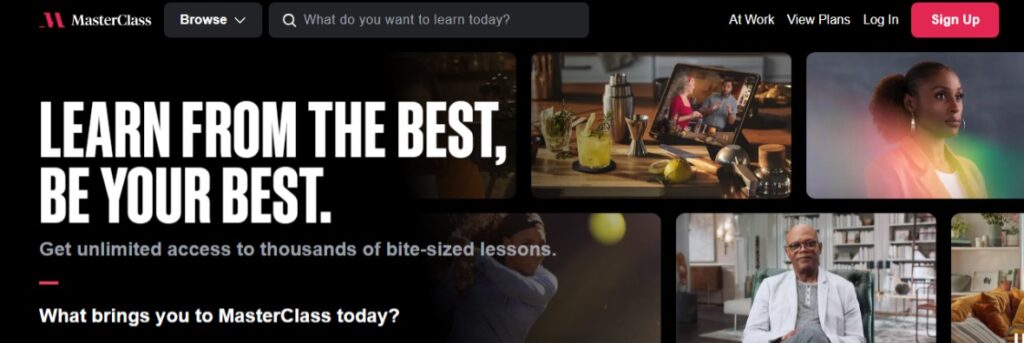
MasterClass is a platform that lets anyone learn from the world’s best practitioners, be it Gordon Ramsey for cooking, or Martin Scorsese for film directing.
There are over 180 courses currently available. All beautifully shot, produced and broken down into 15 to 20 bite-sized lessons. The advice is often practical and there are workbooks with extra information available. However, the platform works best for those who want to expose themselves to an overview of lots of different crafts. Or, for those who want to learn from their favourite celebrities!
For content creators, unfortunately, you won’t be able to create and launch a course with MasterClass unless you are pre-approved by them.
G2 Score: 4.5/5
MasterClass Pricing
Billed annually, MasterClass costs $10 per month on an Individual plan, $20 for Duo (which allows access on 2 devices) and $23 for Family (up to 6 devices).
| Pros Celebrity instructors High-quality videos and unique content Introductory knowledge in most courses | Cons No ability to measure progression Smaller content creators cannot freely publish courses |

Another one of the top online learning platforms is Khan Academy. Started by Sal Khan as a way to help his cousins study math, today, Khan Academy features over 10,000 video lessons on various topics.
Most of the platform revolves around foundational topics that you would learn in school such as sciences, math, accounting, physics, and economics. It’s a great resource center for parents that want to help their child access an informative, engaging, and affordable version of online tutoring.
Over 999 million lessons have been delivered on the platform, helping people of all ages and levels of study with their homework! There are streaks and other gamification features built-in to motivate students to learn more, and there are clear progressions for most tracks, sometimes enough for years of study.
G2 Score: 4.5/5
Khan Academy Pricing
Absolutely free! Khan Academy is a non-profit.
| Pros Free courses A variety of topics | Cons More focused on K-12 students |
How to monetize your own content on online learning platforms
There are so many online learning platforms and so much to learn on almost any subject imaginable. The best thing is that once you acquire enough knowledge, you can start monetizing it as well through your own courses in your own unique way. All you need is the platform to do it!
For example, Ellie Diop, owner of Ellie Talks Money, launched her course based on personal financial challenges she’s experienced. When looking for some way to generate a new revenue stream, she said her first thoughts were to, “[write] down all the things I knew how to do, all my experience. What I learned working a nine-to-five, and everything I knew about business finance. I looked at how I could give those skills directly to the marketplace, as a coach.” This led her to eventually create 6 courses, which have generated over 3,000 students and over $1,000,000 in revenue within her first year!
As you build your course, a few tips to keep in mind are:
- Reflect on the skills you currently have
- Consider what other people want to learn
- Figure out the best structure for your course
- Determine how to price your course
- Consider how you’ll market your course
- Get feedback from your students about what they like or don’t like
- Continually optimize and refresh your content over time
Start building an online learning platform with Thinkific
Thinkific is an intuitive and easy-to-use course-creation solution that enables you to build and sell courses of any complexity. No coding skills required — just use a professionally designed template and customize it to your liking using a drag-and-drop editor. As a result, you can create a course in an hour and monetize it for years to come.
This blog was originally published in January 2023, it has since been updated in February 2024 to include top learning platforms for 2024.






